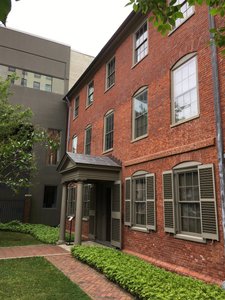Advertisement
Published: June 17th 2017

 Longfellow House
Longfellow House
Another view of the Longfellow HouseFriday was rainy, so it was a good day to spend in the Brown Library. I know I haven’t mentioned much about my research first because I can’t publish any of the picture I took or publish the information willy-nilly and second, there is nothing exciting about someone sitting at a table for six hours peering at tiny writing and muttering to themselves as they try to translate. But, yesterday I looked at several original documents from the 1700s – the ink faded to brown, the paper so much thicker and textured than our thin, smooth sheets of today, the writing so tiny. I assume it was written small – at least in the private papers – to conserve space and save paper (Curtis, you would have fit right in). At the time, I couldn’t think beyond the writing and trying to decipher what it said. I was mostly trying to read a sermon from March of 1775. It was much less fire and brimstone than I was expecting, and the writing itself! They were still using the long s (the one that looks like an f) and because the writing was small and somewhat cramped, each one was a debate

 Flatbread Company
Flatbread Company
Such good food! Go if you have the chance!– f or s? Then, he didn’t finish all his words, using shortcuts for –ing endings and abbreviations for “that,” “they”, “you,” and “us.” Added to that words that I just couldn’t decipher or that have fallen out of use... After about a half hour, I was just mostly jealous of people who will research our lives and the fact that most of what they read will be typed. Later it occurred to me: I had held something 200+ years old in my hands. What I had touched had been written less than a month before the American Revolution began and heard by those who would soon lose their homes to British bombardment and some their lives to the cause of freedom.
When the library closed at 4, I had to leave, so food (Flatbread Company again – really, their food is excellent) and then to the Portland Science Center where National Geographic has the exhibit Real Pirates! It was a pretty good exhibit detailing the history of the Whydah – a slave ship captured by the pirate Sam Bellamy which then sunk in a storm off the coast of Cape Cod. The <em style="mso-bidi-font-style:

 The Whydah
The Whydah
A replica of the bell from the Whydah.normal;">Whydah has now been recovered and is being preserved. Wonderfully for me, it walked through the 10 steps to fire a cannon on a ship (yay research!) and had a grenade on display as well. The little kids going through the exhibit loved it. The only thing that would have made it better would have been costumed actors...
Then it was time for a rather wet ghost tour with Wicked Walking Tours. Our guide, Gordon, was great – entertaining and funny. The stories were a mix of historical and modern experiences Gordon had been told of. A very fun tour!
Now I had off to Camden, ME for a week of sailing, so look for the next post sometime on the 25
th or 26
th.
Advertisement
Tot: 0.092s; Tpl: 0.016s; cc: 10; qc: 30; dbt: 0.0256s; 1; m:domysql w:travelblog (10.17.0.13); sld: 1;
; mem: 1mb

 Longfellow House
Longfellow House
 Flatbread Company
Flatbread Company
 The Whydah
The Whydah




